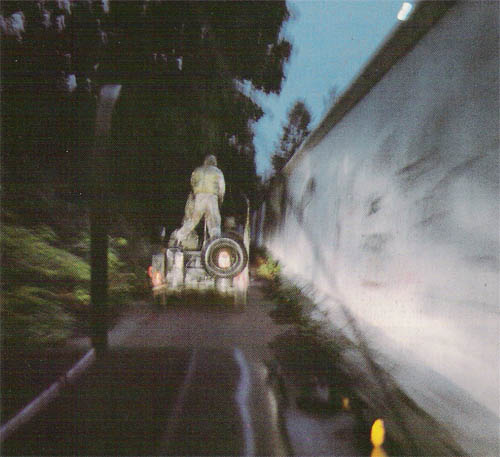This article was published in the Ariman magazine in April 1987.

Saturday night fell as four Army jeeps sped west on Konigstrasse in West Berlin. Motorists in Mercedes and Porsches cast curious looks at the rear of the first jeeps, where soldiers stood gripping pedestal-mounted M-60 machine guns.
Assigned to the Army's Berlin Brigade, these men were beginning a patrol of the Berlin Wall. They'd travel nearly 100 miles over the next six hours, crisscrossing the city to patrol what East Germany built as the "anti-facist protection barrier."
 Spec. 4 Philip Ladue drives through the Berlin dusk. Jeep side-mirrors are pulled in during narrow passages between buildings and the wall. Routes, times and places visited vary for patrols along what East Germany built as the "anti-fascist protection barrier."
Spec. 4 Philip Ladue drives through the Berlin dusk. Jeep side-mirrors are pulled in during narrow passages between buildings and the wall. Routes, times and places visited vary for patrols along what East Germany built as the "anti-fascist protection barrier."
Just the patrol's presence can be a lifesaver. In 1985, East German guards firing at a fleeing man stopped when an American patrol drove into view. The man scrambled over the wall to freedom.
Tonight's patrol members were from the scout platoon, Combat Support Company, 4th Battalion, 502nd Infantry. Their first stop unfolded like a scene from a war movie. The jeeps rumbled up to the head of the Glienicker Bridge leading to Potsdam. Here, on this span nicknamed "Freedom Bridge," U-2 pilot Gary Francis Powers was traded for Soviet spy Rudolf Abel in 1962.
 Sgt. Edward Fernley on Glienicker Bridge. Soldiers wear flak vests and carry .45-caliber pistols.
Sgt. Edward Fernley on Glienicker Bridge. Soldiers wear flak vests and carry .45-caliber pistols.
A crowd of camera-toting tourists drew back as the jeeps drove onto the sidewalks. SSgt. Frederick Whitcombe, outfitted like the rest of his patrol with a flak vest and .45-caliber pistol, strode to the middle of the bridge with Sgt. Edward Fernley. They stopped at the 6-inch-wide white stripe marking the West Berlin-East German border.
At the bridge's other end, two East German guards peered at the men through binoculars. After a final look, the Americans walked purposfully back to the jeeps.
Wall patrol is a coveted duty rotation among brigade units. Volunteers must be infantry, weapons qualified, and pass interviews to be considered. Patrols are usually six men in two jeeps sent out daily. Times vary, as do routes and places visited.
"We get to see things other people only talk about, like the other side's vehicles and weapons," Sergeant Fernley said. "Classes on the Soviet threat are great, but seeing it up close makes it real."
More than 200 East German guard towers are irregularly spaced along West Berlin's border. The city's entire border runs between Berlin's Soviet sector and districts controlled by the United States, Britain and France, as well as between West Berlin and East Germany. At least two guards are assigned to each tower. Partners seldom work together more than once.
"During the winter month, guards sometimes huddle around a fire barrel and aren't paying attention," said Spec. 4 Philip Ladue, a driver. "A few times they've even been sleeping."
Guard occasionally flash V-signs with their fingers at the patrols. Some hold up a "short-timer" chain whose links indicate how many month he has left in the military. "If a short-timer is in a tower with a hard-core partner, he'll stand behind him and hold up the chain so we can see it but his partner won't," Specialist Ladue said.
The gunner's job is the toughest. Knees flexed, he rode out bumpy roads like a skier going over moguls. Windshields are removed, so the cold cut through the soldiers' many layes of clothes. While hail can leave welts on faces, gunners say the biggest hazard is low-hanging tree branches at night.
Whatever the weather or hours, enthusiasm for the mission runs high. "I love it," Sergeant Whitcombe said. "I've never had a bad patrol."

Straddling back of jeep makes gunner's job grueling. Low-hanging branches are unwelcome distractions.




